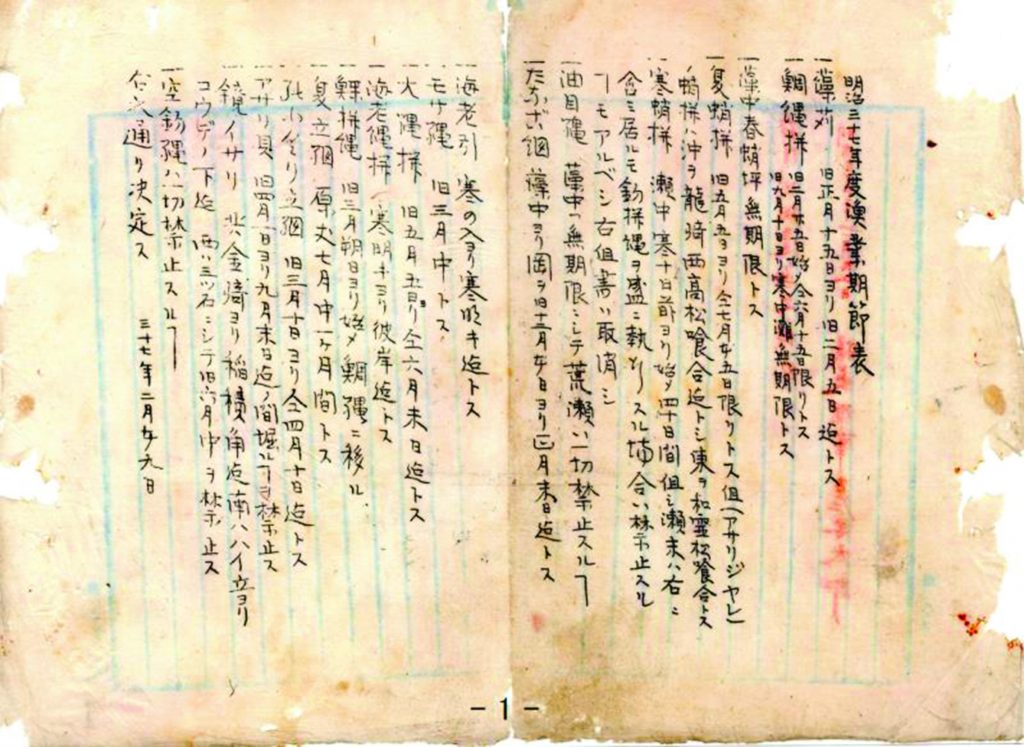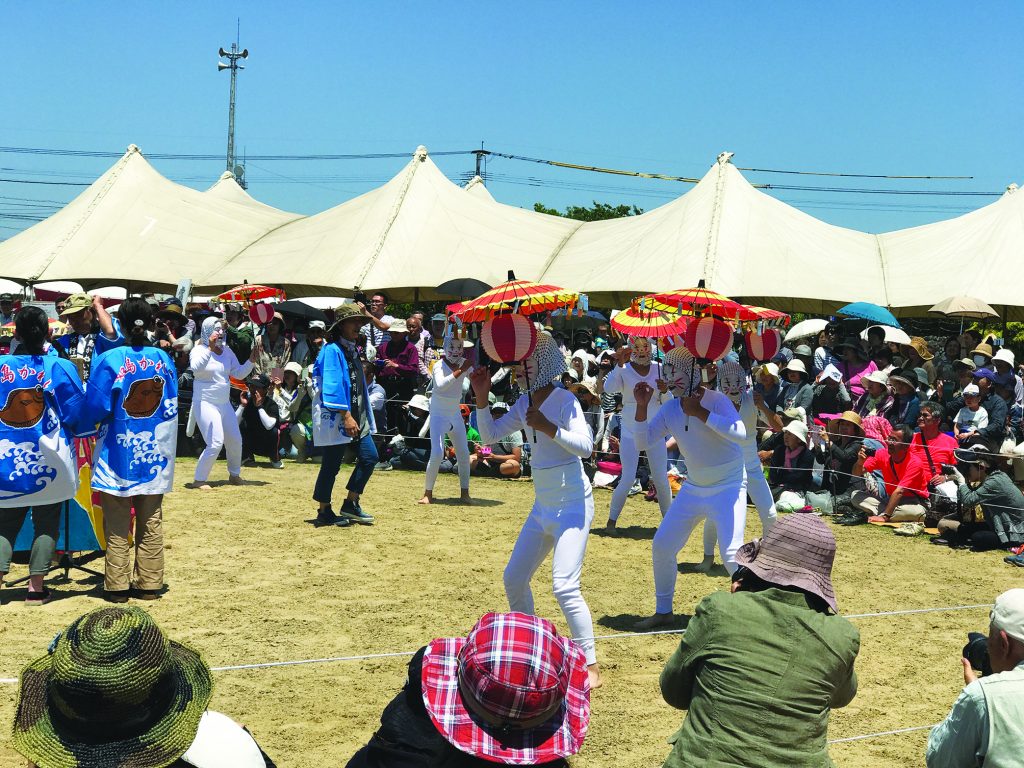The management of small-scale fishing in Hime-shima in Oita Prefecture in western Japan shows how collaboration on traditional knowledge and practices can help overcome external threats
This article is by Nobuyuki Yagi (yagi@g.ecc.u-tokyo.ac.jp), professor at the University of Tokyo and Member of the Science Council of Japan
Japan’s traditional ways for fishery resource management were developed more than 200 years ago. A document written in 1816, called the ‘Edo-Bay Protocol’ (Edo is the ancient name for Tokyo), indicates that 44 coastal communities in the Tokyo Bay agreed that (i) conferences of the fishers shall be held annually, with a host community being assigned on a yearly rotation; (ii) no new fishing method or equipment shall be permitted other than the existing 38 methods in the area; and (iii) all parties shall abide by this agreement.
… although a strong Samurai government ruled Japan in the 19th century—the so-called Edo Era—local communities took a bottom-up approach to fishery management
Coastal communities in Japan have thus long adopted a bottom-up approach for fisheries management. Neighbouring communities agreed upon the borders of fishing grounds so that they could exclusively manage the water area in their locale. This deterred outsiders from accessing fishery resources and thus provided an avoidance mechanism against the ‘free rider’ problem of resource management. These agreements also contributed to mitigating conflicts among communities on access to the fishing areas. Interestingly, although a strong Samurai government ruled Japan in the 19th century—the so-called Edo Era—local communities took a bottom-up approach to fishery management.
At the time, this had a necessary social function too. Japan is a mountainous archipelago with narrow arable lands. Killing and eating cattle had been a religious taboo for many generations during the Samurai periods. To support a relatively densely populated territory, food resources from the ocean have historically been utilized. Hence the demand for seafood has been high throughout Japan’s history.
Changing habits
A new government was established in 1868. National borders were opened up for the United States, Russia and European countries. Before this, direct commercial trade with foreign countries was not permitted, with the exception of China, Korea and the Netherlands. The non-Samurai Meiji government abolished several customary practices in Japan, including traditional clothes, hairstyles and food habits. Then, Japanese people began to accept Western cultures and habits, including a pragmatic and utilitarian attitude to eating cattle.

Although the consumption of fish and fishery products in Japan had been greater than meat consumption until recently, the situation was reversed in the early 21st century. Recent data from the Ministry of Agriculture, Forestry and Fisheries (MAFF) shows that per capita yearly consumption of fish and fishery products was 40.2 kg in 2001, but this steadily decreased to 23.8 kg in 2019.
Further, per capita yearly consumption of meat products continuously increased and, in 2011, it exceeded that of fish and fishery products. The current per capita consumption of meat is around 30 kg per year. Several reasons are attributed for this. The most common explanation is that meat, which is easier to cook than fish, better suits the busy lifestyles of city dwellers.
Production decrease
Simultaneously, Japanese production and import of fish and fishery products have decreased in the first two decades of the 21st century. The number of fishers has decreased from 400,000 in the 1970s to 150,000 in recent years, according to MAFF data. This coincides with a decrease in the population of agricultural and fishery villages. This is because many young people prefer to leave the fishing or agricultural communities to live in cities. Japan’s total population has been decreasing since 2016, due to low birth rates.
Keeping tradition alive
The country did not give up on its traditions. The Food and Agriculture Organization of the United Nations (FAO) designates ‘Globally Important Agricultural Heritage Systems’ (GIAHS), which are unique sites of ecological, social and cultural diversity, and traditional knowledge. Fishery is included as a category in Agriculture. Some fishing communities in Japan are designated as GIAHS sites. One such area is Hime-shima in Oita Prefecture in western Japan.

The Oita GIAHS site is a combined agriculture-and-fishery rural area. Hime-shima (meaning Princess Island) is included in this designated area. It is a small island 7 sq km in size, with a population of 1,600 people. The island’s small-scale fishery is one of the most important sources of income for its people.
They, too, have developed a traditional bottom-up fishing management practice. There exists a 120-year-old document titled ‘Gyogyo-Kisetsu’ or the Seasonal Fishery Regulation Tables. It records the fishers’ agreements since 1904, with details of how the fishing season is managed by species and by gear. This document can be found at the office of the local co-operative, which manages the fishery and sells its products even today. The seasonal regulation table for the year 1904 says: Seaweed gathering starts on 15 January (on the lunar calendar) and ends on 5 February. Longline fishing for seabream (red snapper) starts on 25 February and ends on 25 June. This fishing is also permitted again from 10 September until the winter sets in and the fishery is closed. When it is spring, the octopus fishery using traps and pots is permitted in the seaweed areas. In summer, the octopus fishery starts on 5 May and ends on 25 July. The document also lists other regulations, including the starting and closing days to fish bottom-dwelling species, shrimp, bivalve shellfish species, and so on.
Documented priorities
The first and the most prioritized item of the regulation was seaweed gathering. Seaweed was used as fertilizer in farms at that time. Its monetary value could have been lower than those of seabream, octopus, shrimp or other fish species for direct human consumption. Nonetheless, fisherfolk in 1904 gave the highest priority for the management of seaweed. Local people at the time most likely knew that seaweed was an important habitat for juveniles of several fish species. It needed careful management to sustain commercially important fish species.
This author visited Hime-shima several times before the COVID-19 pandemic. At the local fishery co-operative, which has representatives from each of the seven fishing villages on the island, officials said that since 1904, the seasonal regulation tables have been kept recorded for the year-end general assembly meeting of its members. The procedures for building a consensus and making rules have not changed for more than 100 years. A copy of the notes of a meeting to decide on Gyogyo-Kisetsu in the year 1900 was also found among the records. It suggests that before the official implementation in 1904, similar practices to record agreements among fisherfolk were already in place.
In addition to the seasonal regulation tables, fisherfolk have long implemented area-based regulations such as setting up marine protected areas and conserving forest areas. The fisherfolk’s efforts to conserve forest areas were intentional: Clean water originating from the forest usually contains nutrients such as nitrogen, phosphorus and organic iron. These facilitate seaweed growth. Conversely, without the forest, soil erosion accelerates and the silt or mud flowing into the water harms the seaweed by blocking out sunlight.
The GIAHS designation for Oita in 2013 has boosted collaboration among people in the area to keep their traditions alive. They have implemented product branding strategies for several local agricultural products. The GIAHS tag is also a vehicle for green or blue tourism. Efforts have been made to revitalize these depopulated remote areas, utilizing distinctive tourist attractions.
Collaborating to conserve
Small-scale fisherfolk in Japan are facing serious challenges such as depopulation of their communities, dwindling fish consumption, rising competition from imported fish products, and increased threats to the ocean environments due to climate change. Some are exogenous and fisherfolk are not capable of resolving these issues on their own.
Revitalization of local fishing communities may need additional measures such as the promotion of tourism, and branding strategies for local livelihoods. Collaborations, both local and international, are ongoing. One such example is FAO’s GIAHS. The livelihoods of these Japanese fishing communities would be greatly enhanced by communicating and raising awareness about their unique ways of life. This would also help keep alive their traditional knowledge and practices to manage natural resources, giving them the strength to overcome serious external threats.
For more
Globally Important Agricultural Heritage Systems (GIAHS)
https://www.kunisaki-usa-giahs.com
Humans and the Sea
https://base.d-p-h.info/en/fiches/dph/fiche-dph-8786.html